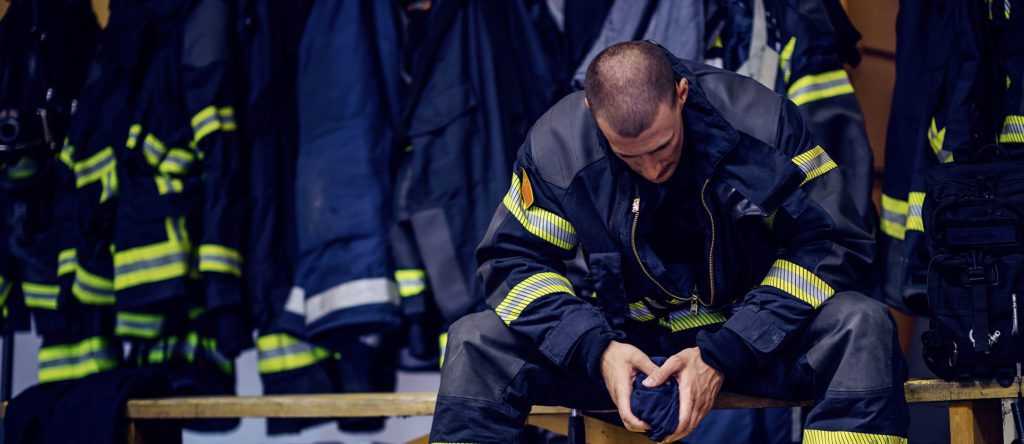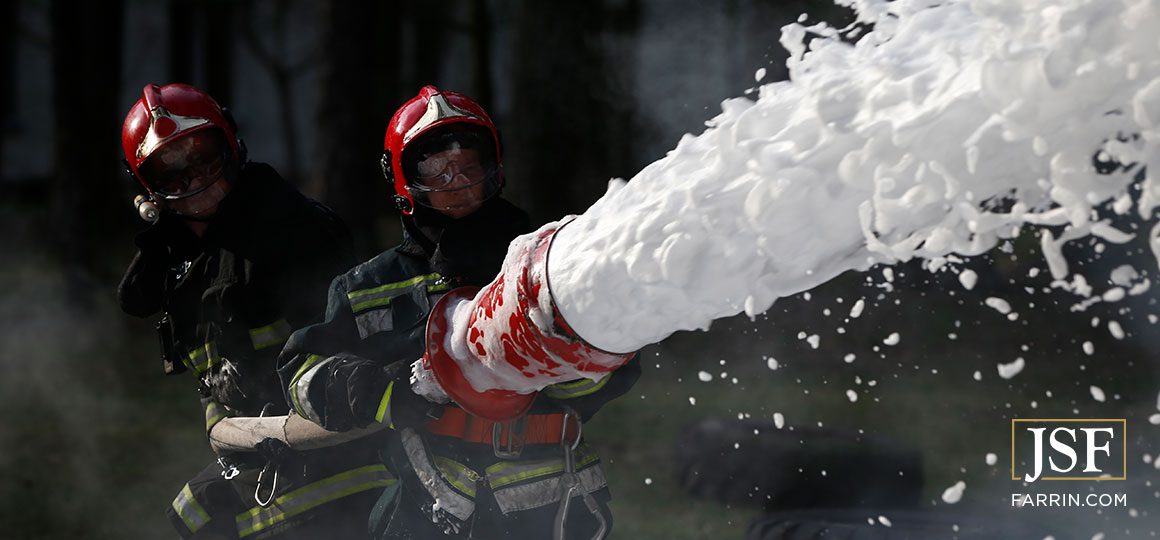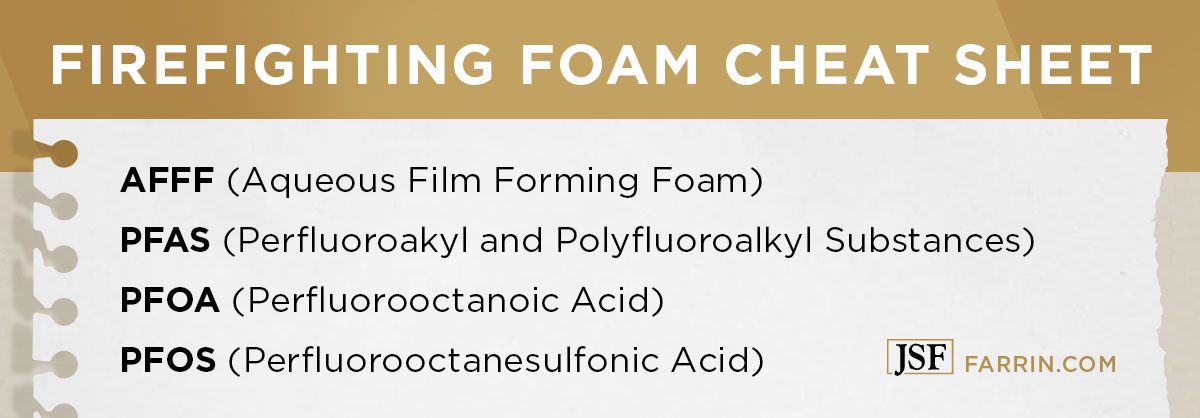
Are you sick because you worked with firefighting foam? Contact an attorney.
Firefighting foam may be responsible for cancer and other serious diseases that firefighters are struggling with now.
AFFF Foam Lawsuit: Firefighting Foam Linked to Cancers
A note to all the brave, hardworking firefighters who have worked with AFFF foam:
Thank you. Thank you for putting it all out there. Thank you for risking everything to ensure the safety of others. We appreciate your hard work, your commitment to your job, and your dedication to helping others.
It is not right that you were exposed to potentially dangerous and life-threatening chemicals while doing your job. While we all now know that exposure to elevated levels of certain chemicals found in AFFF firefighting foam may cause increased cancer risk and other serious health issues, you did not have this information while you were fighting fires and practicing to fight fires.
We believe that the manufacturers of AFFF foam have been aware of the risks for a long time. And yet, they still produced and sold the foam that you used to fight fires to protect others. If you worked with AFFF foam and developed cancer, you may be entitled to compensation.
We want to help you. We want to fight for your rights.
What is AFFF Foam?
In the 1970s, the Department of Defense (DOD) started using aqueous film forming foam (AFFF) solutions to extinguish Class B fires involving flammable and combustible liquids or gases, such as aircraft and jet fuel fires.
How Did AFFF Foam Begin?
Because jet fuel is made to burn, when airplanes crash, their fuel reserves can produce a massive fireball. Water, which doesn’t mix with fuel, often just boils off or sinks under the fuel itself. In the 1960s, the Navy worked with chemical manufacturer 3M to produce a product that would help extinguish these huge, violent fires, and AFFF foam was born. The sudsy foam smothered these fires largely due to the PFAS within the formulation.
What Are PFAS in Firefighting Foam?
AFFF foam contains perfluoroalkyl and polyfluoroalkyl substances (PFAS), a family of man-made fluorinated chemical compounds used to make items heat or water-resistant. In firefighting foam, the PFAS serve as surfactants which, when added to the foam, reduce the foam’s surface tension and increase its spreading and wetting properties. The PFAS help spread the foam to cool and suppress the fire.
The most commonly studied PFAS compounds, perfluorooctane acid (PFOA) and perfluorooctanesulfonic acid (PFOS), are present in firefighting foam.
Do the PFAS in AFFF Foam Cause Cancer?
The PFAS in AFFF foam are linked to adverse health impacts, including the risk of cancer. The Centers for Disease Control and Prevention (CDC), National Center for Environmental Health (NCEH), and Agency for Toxic Substances and Disease Registry (ATSDR) have declared that human exposure to PFAS is a public health concern.
PFAS enter the body through inhalation, ingestion, and absorption, and long-term exposure to PFAS/PFOA/PFOS causes buildups in the body. Exposure to elevated levels of PFAS and to products containing PFAS, such as firefighting foam, increases the risks of contracting:
- Testicular cancer
- Kidney cancer
- Bladder cancer
- Pancreatic cancer
- Liver damage
- Thyroid disease
- Immune system issues

Who Is at Risk of Cancer From the PFAS in Firefighting Foam?
Sadly, many hard-working people have been exposed to these dangerous chemicals – just by fulfilling their normal work duties.
The U.S. military widely used AFFF foam starting in the 1960s. While effective at putting out massive fuel fires at crash sites, the foam was more frequently used in the fire-training exercises that the military used to prepare its firemen for handling these fires. Consequently, some of the brave military firemen who chose a career focused on saving and protecting others are now dealing with PFAS-related cancer and diseases.
By the late 1970s, AFFF foam was also used in U.S. commercial airports, airport hangars, oil refineries, heliports, petrochemical transfer and production sites, as well as in many civilian fire departments. It was not until 2018 that the Federal Aviation Administration (FAA) created a mandate to stop requiring airports to use AFFF foam after October 2021. Therefore, individuals who used, or continue to use, this firefighting foam in their jobs in these commercial industries are also at risk.
If you have cancer and believe that it developed due to your exposure to firefighting foam, call us immediately at 1-866-900-7078 for a free and confidential case evaluation.
Do You Have Grounds for a Firefighting Foam Lawsuit?
If you were a firefighter on a military base or worked with AFFF foam at a commercial site and have developed cancer or other serious health problems, you may have grounds for an AFFF lawsuit against the manufacturer of the firefighting foam.
Some believe that the manufacturers of AFFF, such as 3M Company, DowDupont, Inc., and Chemguard, Inc., knew about the dangerous impacts of PFOS and PFOA on people and the environment. Previous claimants have asserted that these manufacturers were aware that their firefighting foam contained toxic chemicals that impacted the environment when used for fire protection, fire training, and fire response, even when the foam was used as directed.
Claimants have also asserted that 3M conducted tests in the 1970s and 1980s which revealed toxic levels found in the bodies of workers but concealed this knowledge from the public and the Environmental Protection Agency (EPA).
When manufacturers deny their responsibility to the public of producing safe products, it sometimes falls to the individual to stand up and try to hold these companies accountable. If you have developed cancer and believe it is from your exposure to AFFF foam, contact us now. We want to help you seek the compensation you may deserve.
What Could an AFFF Foam Lawsuit Be Worth?
A lawsuit against AFFF foam manufacturers would seek compensation for the harms and losses you have suffered due to your AFFF-related illness including:
- Medical expenses incurred
- Medical treatment needed
- Lost wages
- Pain and suffering
- Emotional trauma
Don’t wait and suffer in silence. Responsible manufacturers should live up to their responsibilities and admit to the harm caused.
How Much Would an Attorney Cost for a Firefighting Foam Lawsuit?
At the Law Offices of James Scott Farrin, we work on a contingency fee basis which means there is no out-of-pocket cost to hire us because there is no hourly fee.2 We have successfully handled defective product cases1 and have helped clients seek justice when their health has been compromised after using a dangerous product.
How Do I Contact an Attorney?
Some in the legal and medical community are carefully examining the actions of AFFF foam manufacturers and critically questioning whether they knew of the health risks of their firefighting foams. If you’ve been hurt, join other victims by filing legal claims against these companies. Call us immediately at 1-866-900-7078 for a free and confidential case evaluation. Let us help you fight for compensation for the damage done to you or your loved one’s health.



